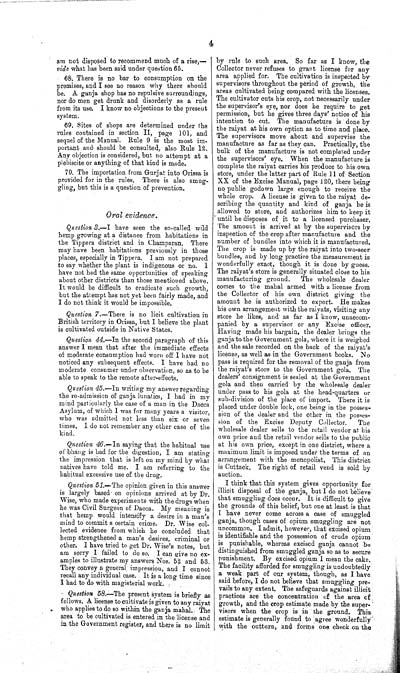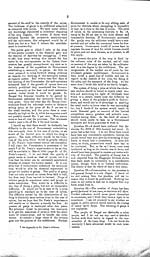Medicine - Drugs > Report of the Indian Hemp Drugs Commission, 1894-1895 > Volume IV
(18) Volume 4, Page 4
Thumbnail gallery: Grid view | List view

4
am not disposed to
recommend much of a rise,—
vide what has been said under question 65.
68. There is no bar to consumption on
the
premises, and I see no reason why there should
be. A ganja shop has no repulsive surroundings,
nor do men get drunk and disorderly as a rule
from its use. I know no objections to the present
system.
69. Sites of shops are
determined under the
rules contained in section II, page 101, and
sequel of the Manual. Rule 9 is the most im-
portant and should be consulted, also Rule 12.
Any objection is considered, but no attempt at a
plebiscite or anything of that kind is made.
70. The importation from
Gurjat into Orissa is
provided for in the rules. There is also smug-
gling, but this is a question of prevention.
Oral evidence.
Question 3.—I have seen the
so-called wild
hemp growing at a distance from habitations in
the Tippera district and in Champaran. There
may have been habitations previously in those
places, especially in Tippera. I am not prepared
to say whether the plant is indigenous or no. I
have not had the same opportunities of speaking
about other districts than those mentioned above.
It would be difficult to eradicate such growth,
but the attempt has not yet been fairly made, and
I do not think it would be impossible.
Question 7.—There is no licit
cultivation in
British territory in Orissa, but I believe the plant
is cultivated outside in Native States.
Question 44.—In the second
paragraph of this
answer I mean that after the immediate effects
of moderate consumption had worn off I have not
noticed any subsequent effects. I have had no
moderate consumer under observation, so as to be
able to speak to the remote after-effects.
Question 45.—In writing my
answer regarding
the re-admission of ganja lunatics, I had in my
mind particularly the case of a man in the Dacca
Asylum, of which I was for many years a visitor,
who was admitted not less than six or seven
times. I do not remember any other case of
the
kind.
Question 46.—In saying that the
habitual use
of bhang is bad for the digestion, I am stating
the impression that is left on my mind by what
natives have told me. I am referring to the
habitual excessive use of the drug.
Question 51.—The opinion given
in this answer
is largely based on opinions arrived at by Dr.
Wise, who made experiments with the drugs when
he was Civil Surgeon of Dacca. My meaning is
that hemp would intensify a desire in a man's
mind to commit a certain crime. Dr. Wise col-
lected evidence from which he concluded that
hemp strengthened a man's desires, criminal or
other. I have tried to get Dr. Wise's notes, but
am sorry I failed to do so. I can give no ex-
amples to illustrate my answers Nos. 52 and 53.
They convey a general impression, and I cannot
recall any individual case. It is a long time since
I had to do with magisterial work.
Question 58.—The present system
is briefly as
follows. A license to cultivate is given to any raiyat
who applies to do so within the ganja mahal. The
area to be cultivated is entered in the license and
in the Government register, and there is no limit
by rule to such area. So far as I know, the
Collector never refuses to grant license for any
area applied for. The cultivation is inspected by
supervisors throughout the period of growth, the
areas cultivated being compared with the licenses.
The cultivator cuts his crop, not necessarily under
the supervisor's eye, nor does he require to get
permission, but he gives three days' notice of his
intention to cut. The manufacture is done by
the raiyat at his own option as to time and place.
The supervisors move about and supervise the
manufacture as far as they can. Practically, the
bulk of the manufacture is not completed under
the supervisors' eye. When the manufacture is
complete the raiyat carries his produce to his own
store, under the latter part of Rule 11 of Section
XX of the Excise Manual, page 120, there being
no public godown large enough to receive the
whole crop. A license is given to the raiyat de-
scribing the quantity and kind of ganja he is
allowed to store, and authorizes him to keep it
until he disposes of it to a licensed purchaser.
The amount is arrived at by the supervisors by
inspection of the crop after manufacture and the
number of bundles into which it is manufactured.
The crop is made up by the raiyat into two-seer
bundles, and by long practice the measurement is
wonderfully exact, though it is done by guess.
The raiyat's store is generally situated close to his
manufacturing ground. The wholesale dealer
comes to the mahal armed with a license from
the Collector of his own district giving the
amount he is authorized to export. He makes
his own arrangement with the raiyats, visiting any
store he likes, and as far as I know, unaccom-
panied by a supervisor or any Excise officer.
Having made his bargain, the dealer brings the
ganja to the Government gola, where it is weighed
and the sale recorded on the back of the raiyat's
license, as well as in the Government books. No
pass is required for the removal of the ganja from
the raiyat's store to the Government gola. The
dealers' consignment is sealed at the Government
gola and then carried by the wholesale dealer
under pass to his gola at the head-quarters or
sub-division of the place of import. There it is
placed under double lock, one being in the posses-
sion of the dealer and the other in the posses-
sion of the Excise Deputy Collector. The
wholesale dealer sells to the retail vendor at his
own price and the retail vendor sells to the public
at his own price, except in one district, where a
maximum limit is imposed under the terms of an
arrangement with the monopolist. This district
is Cuttack. The right of retail vend is sold by
auction.
I think that this system gives
opportunity for
illicit disposal of the ganja, but I do not believe
that smuggling does occur. It is difficult to give
the grounds of this belief, but one at least is that
I have never come across a case of smuggled
ganja, though cases of opium smuggling are not
uncommon. I admit, however, that excised opium
is identifiable and the possession of crude opium
is punishable, whereas excised ganja cannot be
distinguished from smuggled ganja so as to secure
punishment. By excised opium I mean the cake.
The facility afforded for smuggling is undoubtedly
a weak part of our system, though, as I have
said before, I do not believe that smuggling pre-
vails to any extent. The safeguards against illicit
practices are the concentration of the area of
growth, and the crop estimate made by the super-
visors when the crop is in the ground. This
estimate is generally found to agree wonderfully
with the outturn, and forms one check on the
Set display mode to: Large image | Zoom image | Transcription
Images and transcriptions on this page, including medium image downloads, may be used under the Creative Commons Attribution 4.0 International Licence unless otherwise stated. ![]()
| India Papers > Medicine - Drugs > Report of the Indian Hemp Drugs Commission, 1894-1895 > Volume IV > (18) Volume 4, Page 4 |
|---|
| Permanent URL | https://digital.nls.uk/74552286 |
|---|---|
| Description | Evidence of Bengal witnesses. |
| Description | Volume 4: Evidence of witnesses from Bengal and Assam. |
|---|---|
| Attribution and copyright: |
|




